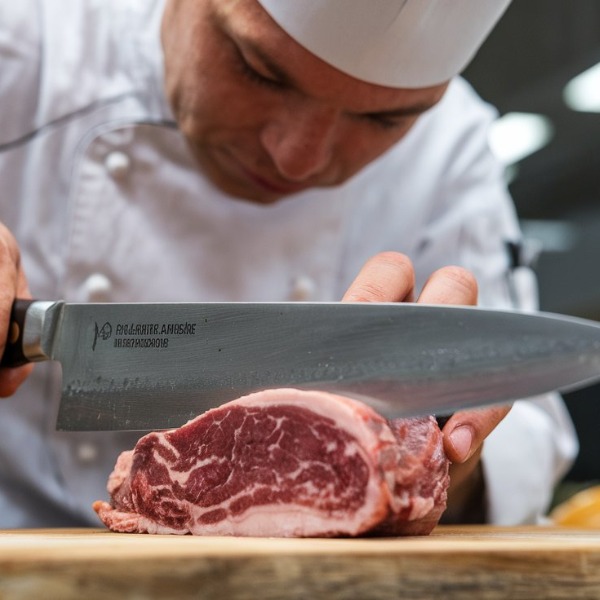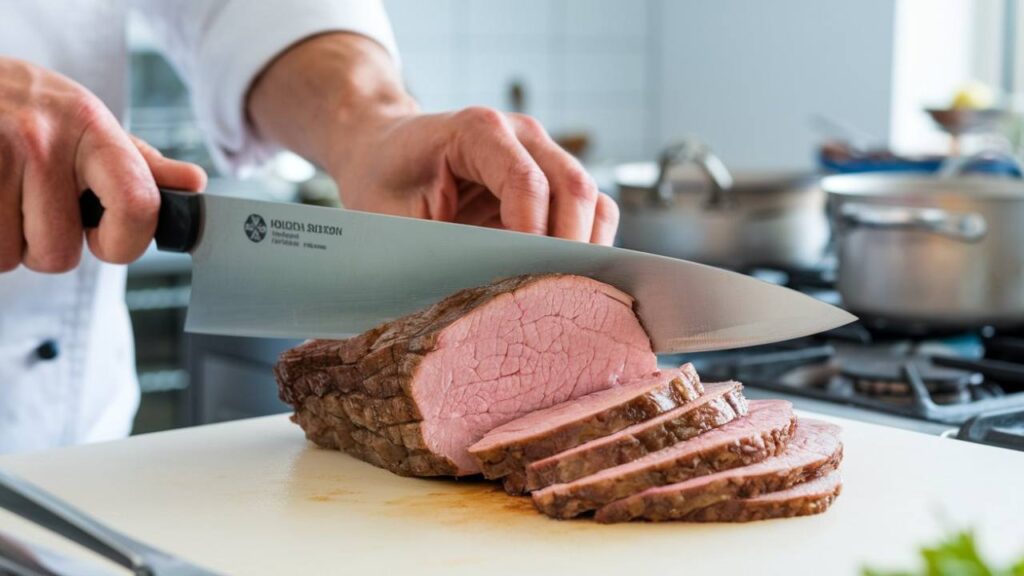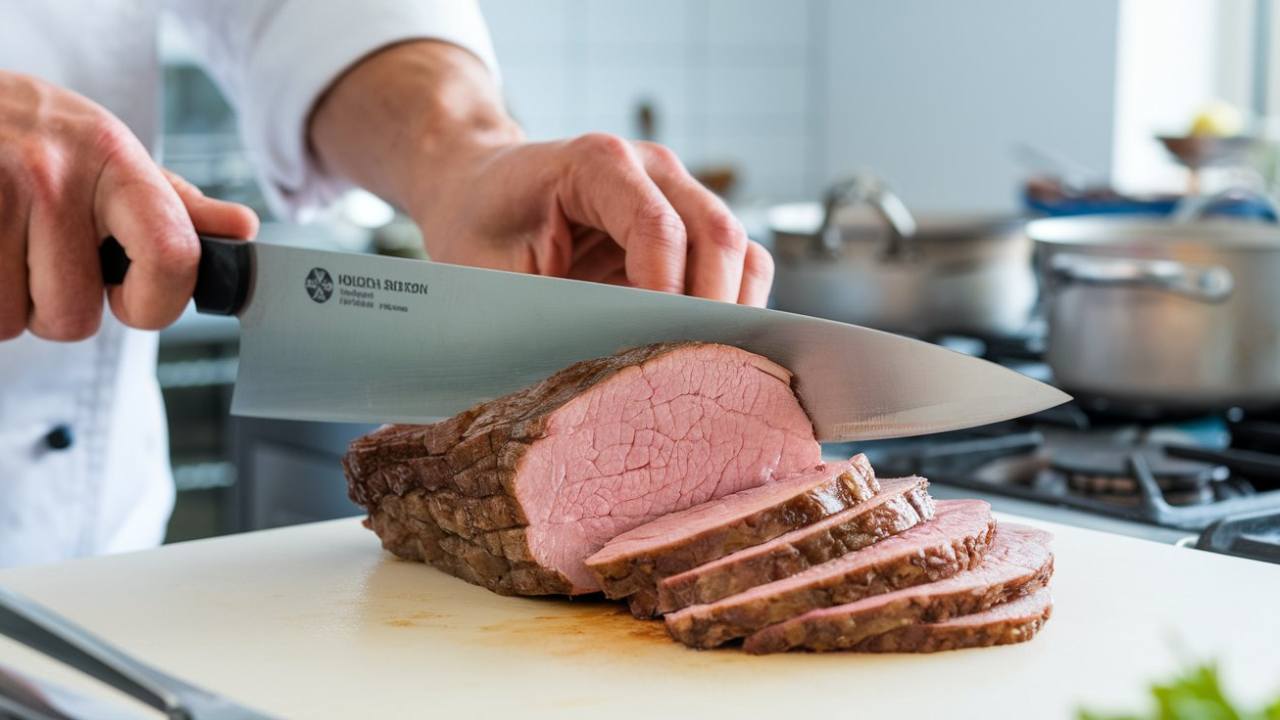Cutting meat is an essential skill in any kitchen, whether you are a seasoned chef or just getting started. But have you ever wondered, “Can you cut meat with a Chef Knife?” The answer is yes, but it takes the right techniques and knowledge to do it correctly. Using a chef knife for cutting meat offers precision, control, and versatility, making it a go-to tool for professionals and home cooks alike. However, cutting meat isn’t as simple as grabbing a knife and getting started.
Let’s explore the nine important things you should know before cutting meat with a chef knife.
Can You Cut Meat with a Chef Knife?

A chef knife is a versatile kitchen tool designed for a variety of tasks, including cutting meat. But to use it effectively, there are several factors to consider, such as the type of meat, knife maintenance, and proper techniques. Understanding these aspects can make your meat-cutting process safer, easier, and more efficient.
1. Choose the Right Chef Knife
When it comes to cutting meat, selecting the right chef knife is crucial. A good chef knife should have a sharp blade, comfortable grip, and appropriate length. For instance, an 8-inch knife works well for most types of meat, while a longer blade may be better for larger cuts.
Key considerations:
- Blade sharpness: A dull knife can crush the meat rather than cut it cleanly.
- Handle comfort: Ensure the knife feels balanced and secure in your hand.
- Blade material: High-carbon steel is often preferred for its durability.
Using the right knife not only makes the process easier but also ensures clean, precise cuts.
2. Keep the Blade Sharp
A sharp chef knife is essential for cutting meat effectively. Dull blades require more force, which can lead to uneven cuts and increase the risk of accidents. Regularly hone your knife with a honing rod and sharpen it as needed. This simple habit can improve your cutting experience and prolong the knife’s lifespan.
3. Understand Meat Structure
Knowing the structure of the meat you’re cutting can make a significant difference. Meat consists of muscle fibers, fat, and connective tissues. Cutting against the grain—the direction in which muscle fibers run—results in tender slices. For tougher cuts, removing excess fat and connective tissue before cutting can improve the final result.
4. Use the Right Cutting Technique
Mastering the correct cutting technique is crucial for both safety and efficiency. Here are some tips:
- Use a rocking motion: This ensures smooth cuts and reduces strain on your wrist.
- Stabilize the meat: Place the meat on a cutting board with a non-slip surface to prevent movement.
- Apply steady pressure: Avoid sawing motions, as they can tear the meat.
5. Prep the Meat Before Cutting
Preparation is key to achieving optimal results. Ensure the meat is properly thawed and at the right temperature before cutting. Cold meat is firmer and easier to slice, while fully thawed meat can be more challenging to handle. Additionally, pat the meat dry with a paper towel to prevent slipping.
6. Use a Proper Cutting Board
A sturdy cutting board provides a stable surface and protects your knife’s blade. Wooden and plastic boards are popular choices for cutting meat. Ensure the board is clean and free of deep grooves that can harbor bacteria. For added safety, place a damp towel underneath the board to keep it from sliding.
7. Practice Food Safety
Handling raw meat comes with the risk of contamination. Follow these food safety tips:
- Wash your hands before and after handling raw meat.
- Use separate cutting boards for meat and other foods.
- Clean and sanitize your knife and cutting board immediately after use.
8. Consider the Type of Meat
Different types of meat require slightly different techniques. For example:
- Beef: Use a sharp blade to cut against the grain for tender slices.
- Poultry: A chef knife is great for separating joints and slicing breast meat.
- Fish: While a fillet knife is ideal, a chef knife can be used for larger cuts.
Understanding the specific requirements of each type of meat ensures better results.
9. Maintain Your Chef Knife
Proper maintenance keeps your chef knife in top condition. Here are some tips:
- Hand wash your knife: Avoid the dishwasher, as it can damage the blade.
- Store it safely: Use a knife block or magnetic strip to prevent dulling.
- Regularly inspect the blade: Check for nicks or imperfections that can affect performance.

Chef Knife Tips for Cutting Meat
| Tip | Description |
|---|---|
| Choose the Right Knife | Select a sharp, balanced knife with a comfortable grip. |
| Keep Blade Sharp | Regular honing and sharpening improve efficiency. |
| Understand Meat Structure | Cut against the grain for tender slices. |
| Use Correct Technique | Stabilize meat and use a smooth, rocking motion. |
| Prep Meat Properly | Thaw and dry meat for easier handling. |
| Use Proper Cutting Board | Choose a stable, clean board to protect your knife. |
| Follow Food Safety | Prevent contamination by cleaning tools and surfaces. |
| Consider Meat Type | Adjust techniques for beef, poultry, or fish. |
| Maintain Your Knife | Hand wash and store properly for longevity. |
Related Article: 7 Best Beginner-Friendly Knives to Master Cooking Skills
Conclusion
Cutting meat with a chef knife is a skill that can elevate your cooking experience. By following these tips, you can ensure clean, precise cuts while maintaining safety and efficiency. From choosing the right knife to mastering cutting techniques, these steps are designed to help you get the best results. So, the next time someone asks, “Can you cut meat with a Chef Knife?” you’ll not only know the answer but also have the skills to back it up.
FAQ’s
Can you cut raw meat with a chef knife?
Yes, a chef knife is ideal for cutting raw meat, provided it’s sharp and properly maintained. Use clean tools to ensure food safety.
What is the best technique for cutting meat with a chef knife?
The rocking motion is the most effective technique for cutting meat. Stabilize the meat on a secure cutting board and cut against the grain for tender slices.
How do I keep my chef knife sharp?
Regular honing and occasional sharpening keep your chef knife sharp. Avoid cutting on hard surfaces and store it properly to prevent dulling.
Why is it important to cut against the grain?
Cutting against the grain shortens the muscle fibers, resulting in tender and easier-to-chew slices of meat.
What cutting board should I use for meat?
Use a sturdy wooden or plastic cutting board. Ensure it’s clean, stable, and free of deep grooves to maintain hygiene and protect your knife.


One thought on “9 Things You Should Know Before Cutting Meat with a Chef Knife”